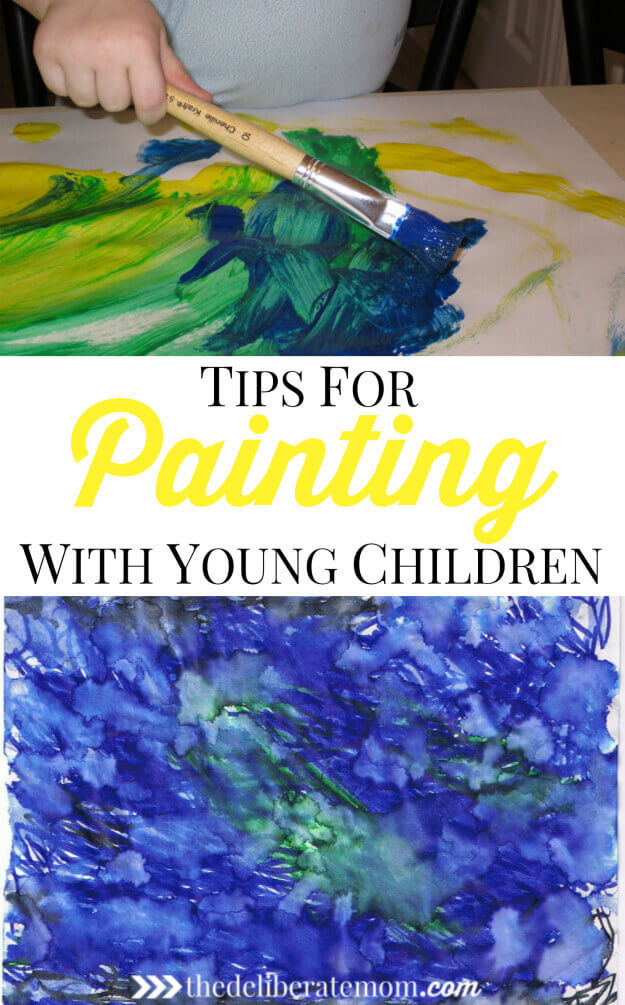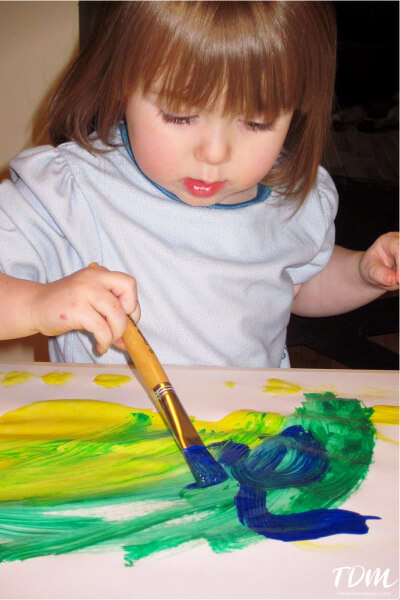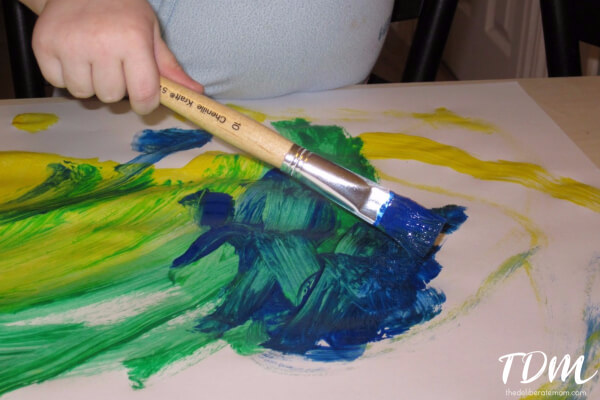Have you ever watched a child paint?
The look of concentration, the way they hold the paint brush, their broad sweeps and fine dabs… the process is fascinating to observe.
This article will share my daughter’s exploration of this particular art medium and will also provide some tips and suggestions to inspire your own little Van Goghs!
Painting with young children does not have to be a daunting task!
Check out these tips on how to teach and encourage young children to paint! Click To Tweet
“Every child is an artist. The problem is how to remain an artist once we grow up.”
Pablo Picasso
My daughter’s exploration of paint started when she was a little younger than two years of age. We had a watercolour set and let her explore wetting the brush, selecting a colour and then sweeping the brush back and forth on a piece of paper.
Her exploration then evolved into her own process. She would draw with some felt markers and then ask for water and a paint brush to “paint” the paper. The results were stunning. Although she is only three, after reading the book Olivia, she had named a number of her paintings “Starry Night”.

Recently, I expanded her painting media repertoire to include liquid tempera paint. I provided 18″ x 24″ paper and a selection of three tempera paint colours. She loved the enormity of the project and she was focused, as well as intent to cover as much of the paper as she could!

So, how can you implement painting into your child’s daily activities? Here are some suggestions to make the process an enjoyable one.
Inspire them
Children don’t necessarily need inspiration but sometimes they need exposure to things they otherwise wouldn’t know of or understand.
- Bring your child to a painting class (as an observer) and allow them to walk around and watch other people painting.
- Bring your child to an art gallery. Some art galleries even have a children’s area so they can explore and interact with art.
- Provide books and pictures of real paintings. Incorporate these into their regular activities. From birth my daughter had a set of Baby Einstein: ABCs of Art Discovery Cards that she would interact with. She would look at the paintings for a long time. When she was a little older she would remove the cards one by one from their box and then spend a significant amount of time putting them back in.
Prepare for a mess
You have to be okay with the mess that this activity will bring. However, adequate preparations will make the mess and clean-up more manageable.
- If you don’t want paint on the table or floor, then cover the surfaces with drop cloths. Inexpensive reusable plastic tablecloths work really well.
- If using tempera paint, premix the paint with some dish soap. This simple step will make clean-up a lot easier.
- Prepare a sink or bucket of warm, soapy water.
- Dress your child appropriately for this activity. This is not the time for your child to wear his/her finest clothes. Have them wear old clothes, pajamas, or a paint smock over their clothes. Plastic paint smocks can be bought from many toy and art supply stores. However, one of daddy or mommy’s old shirts also works well as a paint smock.
- Dress yourself for this activity. You may get a little messy too, so don’t wear your best jeans.
Be organized
Before starting this activity, be organized.
- Have all the materials ready ahead of time to allow your child an easy transition into the activity. This means filling your paint pots with the selected colours, gathering brushes and preparing paper.
- Designate a space to dry paintings. Collapsible clothes drying racks make a great place for paintings to dry.
- Have a pen/marker and some masking tape handy so you can document the date and any “narration” your child provides during the process. The tape can be easily stuck on the back of the artwork for future reference.
- Don’t forget your camera.

Inspire them… again
Inspiration can keep an interest exciting. Here are some additional ways to inspire your children if they’ve already had numerous experiences painting.
- Provide alternate types of media to paint on (i.e. watercolour paper, canvas, ceramic tiles, etc.)
- Set up an inspiring arrangement of flowers, plants, fruits or rocks in the immediate painting area.
- Take the activity outside. Set up the painting activity in the great outdoors and allow nature to be the inspiration!
Tips for success
Here are some tips to make the process more successful.
- Tape the paper your child will be using to the table or the easel. A paper that doesn’t move makes the experience less frustrating.
- There’s no need to provide a whole rainbow of colours. Have your child select three colours… this is more than enough for their initial exploration of this art medium.
- Resealable paint pots help prevent waste and also cuts down on the preparation time needed for subsequent painting sessions.
- Allow plenty of time. Your child may be content with just painting one or two pictures but allow enough time for him/her to paint as many pictures as he/she would like.
- Allow for conversation to flow. Art and art appreciation is a opportune time to introduce new concepts as well as expand your child’s vocabulary.
- This is an amazing opportunity to observe your child’s creative development. Ask yourself how each painting session has changed or evolved. Perhaps your child is doing finer marks whereas previously they were using broad strokes. Maybe they’re experimenting more with the mixing of colours.
How to preserve finished artwork
Treat their paintings like treasures.
-
- Have a few picture frames available so that you can hang and display a rotation of paintings. You can even type up an artist’s card and mount it on black paper to post beside their framed artwork.
- Scan smaller works onto the computer and take photographs of larger pieces of work. Preserve a digital library of their work
- Use digital images of collected art work to make; calendars, greeting cards, post cards, photo collages, coffee mugs, etc.
- Collect original samples of work in a portfolio. I have a great artist’s portfolio. It’s large enough to store bigger pieces of art as well.
Make the experience positive
Children with positive experiences with an activity are more likely to partake in repeated exploration of the activity. Allow them to completely control this process. Do not correct or critique their work. Smile. Observe. Speak gently and softly.
I hope this posting provided some inspiration to motivate your own little Van Goghs. As always, your comments, personal experience and/or suggestions are greatly appreciated.









I really need to relax on the “prepare for a mess” part. I’d love for our kids to be more artistic, but that does mean cleaning up more often. Looks like it’s time to teach them to mop! :)
I definitely want to paint with Dylan and I need to get over the fact there will be mess. Scanning the art is such a good idea! I have so many that he’s done in school that I’m going to scan now that you mentioned it! :]!!!!!
Painting is so much fun! Prepare, take a deep breath, and enjoy!
i love scanning the girls’ art (makes for some great gifts too). I even once used a painting my oldest did on the front of our christmas card one year!
Haha – I love Selena’s comment about ‘teaching them to mop!’
These are wonderful tips, Jennifer. Art is an amazing way for kids to express themselves, work through changes, or grow their creative / imaginative skills. Thank you for sharing this – I’ve pinned it as a resource.
I’m so glad you enjoyed this Sarah! I love painting with my girls… it really is a delightful activity.
Thanks for pinning!
My 4 y/o loves to paint! I love her to paint and even tho I prefer painting to be done outdoors most of the time her painting creations are at our kitchen table. Like you mention I prepare with a ‘painting cloth’ to cover our table and dress my daughter appropriately so we don’t get a nice shirt/outfit messy. We adopted using clip boards to display our children’s artwork because you can easily clip an old one off and clip a new one on!
Painting with young children is awesome! it takes a little bit of preparation but it’s so worth it!
I’ve seen that clipboard idea before… brilliant!